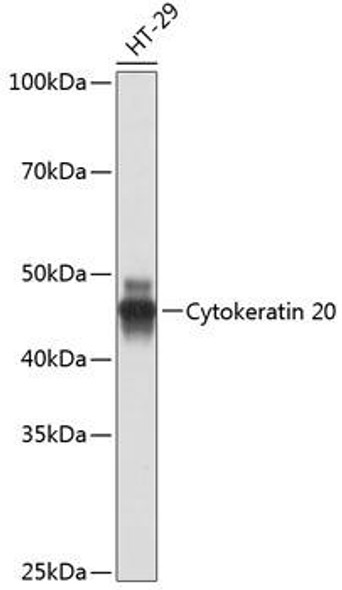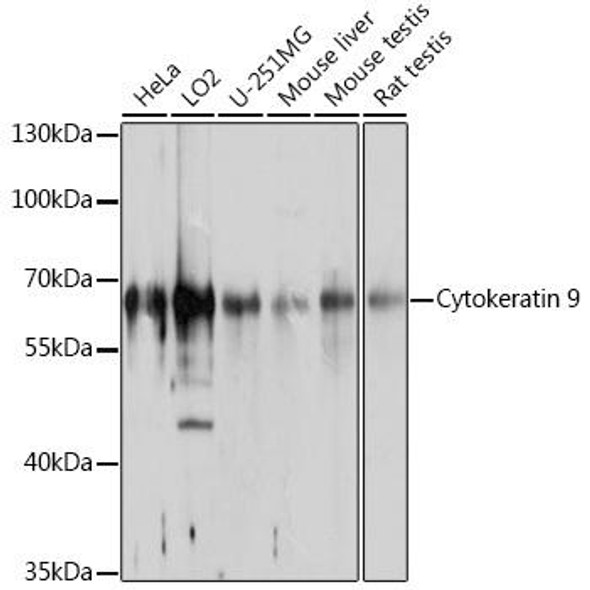Anti-Cytokeratin 13 (KRT13) Antibody (CAB0411)
- SKU:
- CAB0411
- Product type:
- Antibody
- Antibody Type:
- Monoclonal Antibody
- Reactivity:
- Human
- Mouse
- Rat
- Host Species:
- Rabbit
- Isotype:
- IgG
- Synonyms:
- CK13
- K13
- WSN2
Frequently bought together:
Description
| Product Name: | Cytokeratin 13 (KRT13) Rabbit mAb |
| Product Code: | CAB0411 |
| Size: | 20uL, 50uL, 100uL |
| Synonyms: | CK13, K13, WSN2 |
| Applications: | WB, IHC, IF |
| Reactivity: | Human, Mouse, Rat |
| Host Species: | Rabbit |
| Immunogen: | A synthesized peptide derived from human Cytokeratin 13 (KRT13) (KRT13) |
| Applications: | WB, IHC, IF |
| Recommended Dilutions: | WB 1:500 - 1:2000 IHC 1:50 - 1:200 IF 1:50 - 1:200 |
| Reactivity: | Human, Mouse, Rat |
| Positive Samples: | Mouse lung, Mouse uterus |
| Immunogen: | A synthesized peptide derived from human Cytokeratin 13 (KRT13) (KRT13) |
| Purification Method: | Affinity purification |
| Storage: | Store at -20°C. Avoid freeze / thaw cycles. Buffer: PBS with 0.02% sodium azide, 0.05% BSA, 50% glycerol, pH7.3. |
| Isotype: | IgG |
| Sequence: | Email for sequence |
| Gene ID: | 3860 |
| Uniprot: | P13646 |
| Calculated MW: | 50kDa |
| Observed MW: | 50kDa |
| UniProt Protein Function: | K13: a type I cytoskeletal keratin. The keratins are intermediate filament proteins responsible for the structural integrity of epithelial cells and are subdivided into cytokeratins and hair keratins. There are two types of cytoskeletal and microfibrillar keratin: type I (acidic; 40-55 kDa) [K9 to K20] and type II (neutral to basic; 56-70 kDa) [K1 to K8]. Both a basic and an acidic keratin are required for filament assembly. Generally associates with K4 |
| UniProt Protein Details: | Protein type:Cytoskeletal Chromosomal Location of Human Ortholog: 17q21.2 Cellular Component: intermediate filament cytoskeleton; keratin filament; nucleus Biological Process: cytoskeleton organization and biogenesis Disease: White Sponge Nevus 2 |
| NCBI Summary: | The protein encoded by this gene is a member of the keratin gene family. The keratins are intermediate filament proteins responsible for the structural integrity of epithelial cells and are subdivided into cytokeratins and hair keratins. Most of the type I cytokeratins consist of acidic proteins which are arranged in pairs of heterotypic keratin chains. This type I cytokeratin is paired with keratin 4 and expressed in the suprabasal layers of non-cornified stratified epithelia. Mutations in this gene and keratin 4 have been associated with the autosomal dominant disorder White Sponge Nevus. The type I cytokeratins are clustered in a region of chromosome 17q21.2. Alternative splicing of this gene results in multiple transcript variants; however, not all variants have been described. [provided by RefSeq, Jul 2008] |
| UniProt Code: | P13646 |
| NCBI GenInfo Identifier: | 269849755 |
| NCBI Gene ID: | 3860 |
| NCBI Accession: | P13646.4 |
| UniProt Secondary Accession: | P13646,Q53G54, Q6AZK5, Q8N240, |
| UniProt Related Accession: | P13646 |
| Molecular Weight: | 45,867 Da |
| NCBI Full Name: | Keratin, type I cytoskeletal 13 |
| NCBI Synonym Full Names: | keratin 13 |
| NCBI Official Symbol: | KRT13 |
| NCBI Official Synonym Symbols: | K13; CK13; WSN2 |
| NCBI Protein Information: | keratin, type I cytoskeletal 13 |
| UniProt Protein Name: | Keratin, type I cytoskeletal 13 |
| UniProt Synonym Protein Names: | Cytokeratin-13; CK-13; Keratin-13; K13 |
| Protein Family: | Keratin |
| UniProt Gene Name: | KRT13 |
| UniProt Entry Name: | K1C13_HUMAN |









